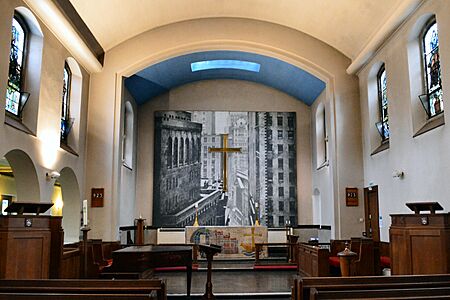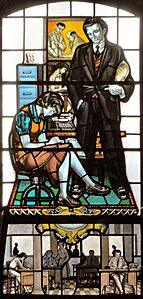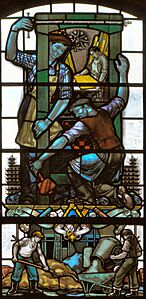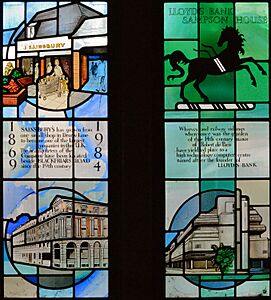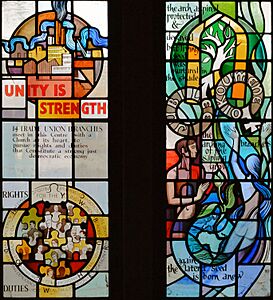Christ Church, Southwark facts for kids
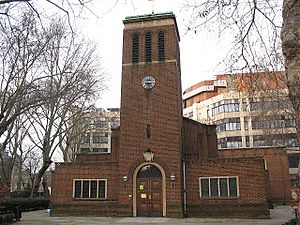
The rebuilt Christ Church
|
|
| 51°30′23″N 0°06′18″W / 51.50626°N 0.10505°W | |
| Country | England |
|---|---|
| Denomination | Church of England |
Quick facts for kids History |
|
| Status | Parish church |
| Architecture | |
| Functional status | Active |
| Heritage designation | Grade II listed |
| Designated | 26 October 2010 |
| Completed | 1958 |
| Administration | |
| Parish | Christ Church Southwark |
| Archdeaconry | Southwark |
| Diocese | Southwark |
Christ Church, Southwark, is a historic church in London, England. It belongs to the Anglican denomination. You can find it on the west side of Blackfriars Road. When it was first built, there wasn't a bridge at Blackfriars. This meant the area wasn't well connected to the city.
The church you see today was finished in 1958. It was rebuilt after the old one was completely destroyed in 1941. This happened during the London Blitz, a time of heavy bombing. The church is now a Grade II listed building. This means it's an important historical site.
Contents
A Church with a Long Story
The area around Christ Church became its own parish in 1682. This happened because of a generous gift from John Marshall. He was a "whitebaker" from a Southwark family. In his will from 1627, he asked for a new church to be built. He also wanted a Rector (a church leader) to be paid in the area called Paris Garden. This part used to be part of St Saviour's parish. John Marshall died in 1631. The first church was built in 1671.
Rebuilding the Church
John Marshall's charity still helps support the church today. The John Marshall Trustees manage this charity. They have gathered a lot of wealth. This money is used to help Rectors in churches across Kent, Surrey, and Lincolnshire. The main purpose of the charity is to maintain Christ Church.
The first church building was on marshy ground. By the 1720s, it was in poor condition and collapsed. So, in 1738, the trustees were allowed to demolish it. They rebuilt the church in an improved area. By 1741, the new Christ Church was finished. It was built in an Italian Romanesque style. It had a clocktower with an octagonal lantern and cupola on top.
The Churchyard and the Blitz
The churchyard stopped being used for burials in 1856. In 1900, the Metropolitan Public Gardens Association turned it into a public garden. The Bishop of Rochester opened it that year. A drinking fountain was added, donated by a kind person named John Passmore Edwards.
The church was sadly destroyed by bombing in 1941. During the attack, a burning cross from the church fell into the churchyard. It scorched the ground where it landed. Today, a stone cross marks this spot. It is near the drinking fountain, which is still there and is also a Grade II listed item. The garden was updated in 2000 with help from the MPGA and others.
John Marshall is remembered inside the church. His family's coat of arms is in the porch. The church hall is also named after him. It is also home to the South London Industrial Mission.
Paris Garden and Today
The church's parish was the same as the manor of Paris Garden. Shakespeare mentioned this area in his play Henry VIII. At that time, it was known as a less respectable place. It was outside the control of the Bishop of Winchester's 'Liberty of the Clink' and the Archbishop of Canterbury's Manor of Lambeth.
Today, this area is a busy office location. It is north of Southwark Station on the London Underground Jubilee line. It is now part of the London Borough of Southwark.
Special Features of the Church
The church has two large sets of stained glass windows. One set is from 1959 by Kenneth Bunton. The other is from 1984 by John Lawson. This second set celebrates the church's 25th anniversary. Both sets show scenes from daily life in the parish.
Stained Glass Details
The 1959 stained glass includes a London Transport bus, which is quite unique! The 1984 glass shows various buildings. These include Sampson House, the Lloyds Bank Computer Centre, Sea Containers House, the Kirkaldy Testing Museum, and a J Sainsbury supermarket. Some of the businesses shown in the 1984 glass have since moved from the area. The stained glass in the nave and sanctuary was made by Frederick Cole.
Other Features
The church hall has a sculpture called New Regime (1989). It was created by Ian Walters and is a memorial to the Wapping dispute.
The church built after the war had a Percy Daniel & Co organ from 1939. This organ was installed by Noel Mander of Mander Organs. It was later removed in 1984. The organ in the church that was destroyed by bombing was an 1871 Henry Jones instrument. It had been restored in 1939 by Percy Daniel. Before that, Jones had rebuilt an even older organ from 1809 by Thomas Elliot.
Images for kids
See also
- List of Churches in Southwark
- Anglican Diocese of Southwark


